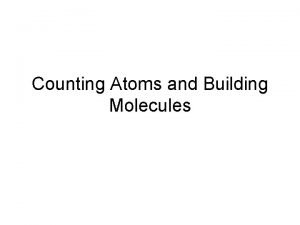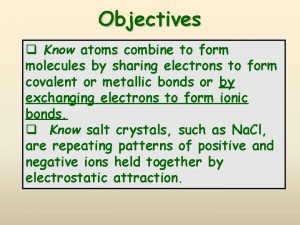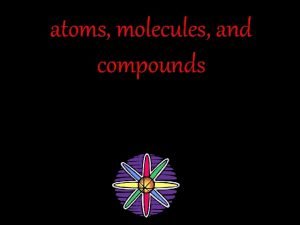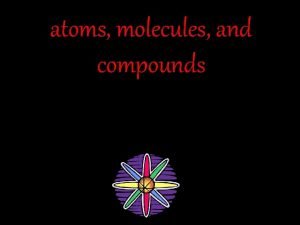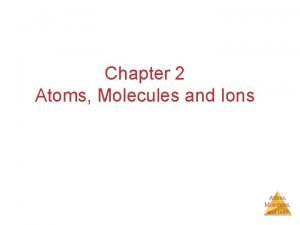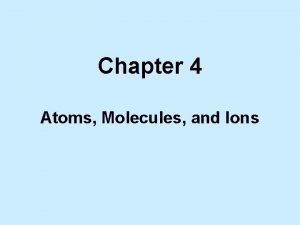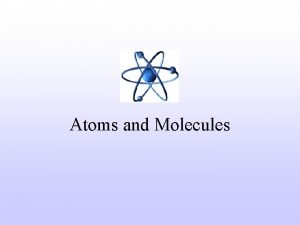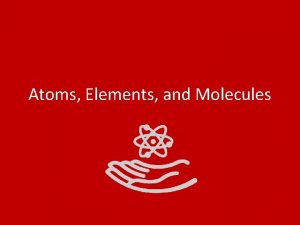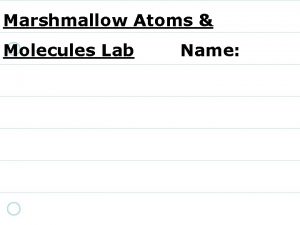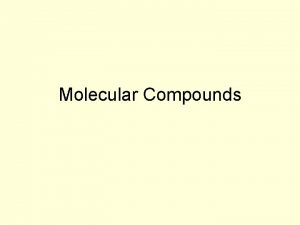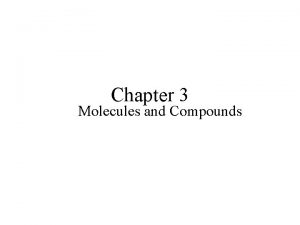Molecular Compounds Molecules and Molecular Compounds atoms held












- Slides: 12

Molecular Compounds

Molecules and Molecular Compounds • atoms held together by sharing electrons are joined by a covalent bonding. • many elements found in nature are in the form of molecules. • a molecule is an electrically neutral group of atoms joined together by covalent bonds.

Molecules and Molecular Compounds • diatomic molecules are molecules consisting of two atoms. • H, N, O, F, Cl, Br, I

Molecules and Molecular Compounds • atoms of different elements can combine chemically to form compounds. • in many compounds, the atoms are bonded to each other to form molecules. • a compound composed of molecules is called a molecular compound.

Molecules and Molecular Compounds • molecular compounds tend to have relatively low melting and boiling points. • many molecular compounds are gases or liquids at room temperature. • most molecular compounds are composed of atoms of two or more nonmetals.

Molecular Formulas • the chemical formula of a molecular compound is called a molecular formula. • a molecular formula shows the kinds and numbers of atoms present in a molecule of a compound. • molecular formulas also describe molecules of elements.

Molecular Formulas • a molecular formula shows how many atoms of each element a molecule contains. • EX: CO - 1 atom of carbon, 2 atoms of oxygen 2

The Nature of Covalent Bonding

The Octet Rule in Covalent Bonding • in forming ionic compounds, electrons tend to be transferred so that each ion acquires a noble gas configuration. • in forming covalent bonds, electron sharing tends to occur so that atoms, with shared electrons included, attain the configurations of noble gases.

Single Covalent Bonds • two atoms held together by sharing a pair of electrons are joined by a single covalent bond. • an electron dot formula such as H: H represents the shared pair of electrons of the covalent bond by two dots. • the pair of shared electrons forming the covalent bond is represented as a dash, H-H

Single Covalent Bonds • a structural formula represents the covalent bonds by dashes and shows the arrangement of covalently bonded atoms. • a pair of valence electrons that is not shared between atoms is called an unshared pair, also known as a lone pair or a nonbonding pair.

Double and Triple Covalent Bonds • atoms form double or triple covalent bonds if they can attain a noble gas structure by sharing two pairs or three pairs of electrons.
 Compound substance
Compound substance What is the relationship between atoms and elements
What is the relationship between atoms and elements How can you count atoms and molecules
How can you count atoms and molecules Atoms molecules and ions
Atoms molecules and ions Atoms molecules and ions
Atoms molecules and ions Atoms molecules and ions
Atoms molecules and ions Atoms molecules and ions
Atoms molecules and ions Atoms ions and molecules
Atoms ions and molecules Atoms ions and molecules
Atoms ions and molecules Collision theory states that
Collision theory states that Chapter 2 atoms molecules and ions
Chapter 2 atoms molecules and ions Organic molecules vs inorganic molecules
Organic molecules vs inorganic molecules Why do atoms combine to form molecules
Why do atoms combine to form molecules


